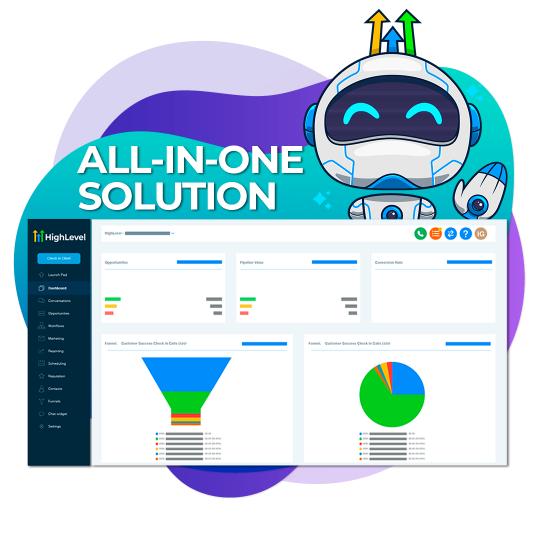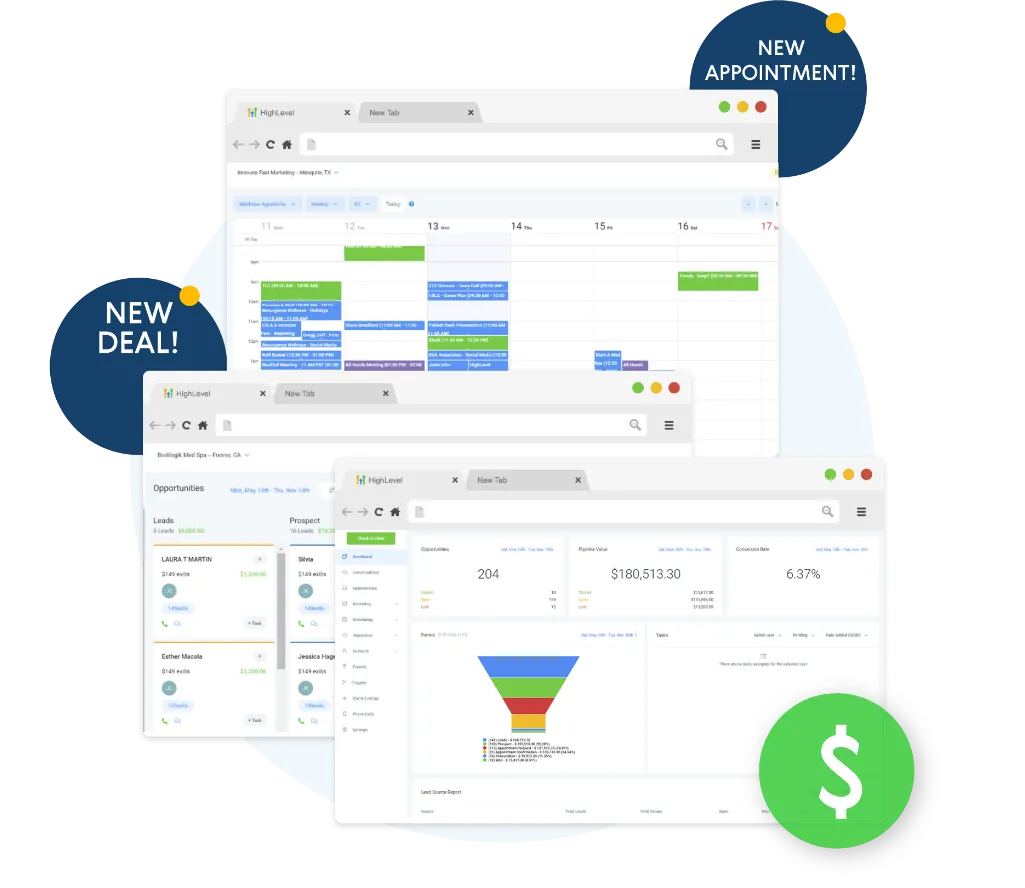Stories work like magic. They've helped people share ideas since Shakespeare wrote his plays. And guess what? They still work great today when you want to sell things!
When you tell a good story about what you're selling, people want it more. Your brain feels happy when you hear stories. This makes you care about what you're buying.
Think about your favorite book or movie. You remember it because it told a good story, right? The same thing works when you tell stories about your business. People will remember you better and trust you more.
Tired of Losing Track of Your Customers and Sales?
A good CRM helps you keep all your customer info in one place. It saves you time by doing the boring stuff for you. You can see who's ready to buy and who needs more help. Plus, it reminds you when to follow up, so you never miss a sale.
Try This Amazing CRM Free for 14 Days – Limited Time Offer!
Key Takeaways
Stories touch our hearts and make our brains light up. This has been true since people first shared tales around fires.
Sales people use stories just like Shakespeare did. They help guide people step by step toward what they want.
We remember stories much better than plain facts. If you tell a story, people will recall it 22 times more than just numbers or data.
Stories work everywhere – from plays on a stage to posts on Facebook. The way we share stories may change, but they still move us.
When you tell a good story, you help people see themselves as heroes. This works in both old books and new ads.
Why Stories Sell

Stories pull us in like magic. Think of the last time you heard a great story – you couldn't stop listening! The same happens when brands tell stories to sell things.
When companies tell good stories about their stuff, people want to pay more for it. In fact, stories can make things cost 27 times more! Most people love it when ads tell stories instead of just showing prices.
When you buy something, you're not just getting an item. You're becoming part of the story behind it. Many people pick what to buy based on these stories. They want real, honest stories from brands they can trust.
Take a bottle of wine or a painting. When they come with a good story, people think they're worth more. This shows that good stories don't just get heard – they make things more special to us.
The Science Behind Story Impact
Stories do amazing things to us. When we hear a good story, our brains make special chemicals that help us feel good and care about others. One chemical makes us happy, another helps us feel close to people, and another keeps us focused on what happens next.
Stories also help us learn better than just reading plain facts. Think of your brain as a big net that catches memories. When you hear a story, many parts of your brain light up at once. This makes it easier to remember what you learned.
Your brain treats stories almost like real life. When you hear a story about someone running, your brain acts like you're running too. This is why stories stick with us for so long.
Brain Chemistry Behind Stories
When someone tells you a story, your brain starts doing something amazing. It's like your brain starts dancing with the storyteller's brain. You both feel the same things together.
Stories make your brain release a special chemical that helps you care about others. This is why you remember stories much better than plain facts. When you hear a good story, many parts of your brain work at once. You see pictures in your mind. You feel emotions. Your body even gets ready to move.
People all over the world react the same way to stories. You'll remember a story much better than a list of facts. This makes stories very good for talking to people and sharing ideas.
Sick of wasting hours on marketing that doesn’t pay off?
What if you could skip the hard work and still grow your business?
Automate your marketing and see how easy it can be to save time and close more deals.
Discover the simplest way to take charge of your business!
Memory Formation Through Narratives
Stories help us remember things in three simple ways. Our brain takes different parts of what happens and puts them together like pieces of a puzzle. Just like every story has a start, a problem, and an end, our mind looks for these same parts to help us remember. When stories make us feel something, they stick in our mind better.
When we learn through stories, our whole brain lights up and works together. It's like using all our senses at once. This helps us learn new things by connecting them to what we already know.
People have been using stories to share and remember things for a very long time. It's how we pass down what we learn to others.
Stories Through The Sales Funnel

Let's tell stories that help people buy from us!
Think of selling like telling a good story. First, we need to catch people's eye. We can do this with fun social media posts. We also share happy stories from our customers.
Next, we show folks how we can help fix their problems. We tell real stories about how we solved these same issues for others.
When people are ready to buy, we show them proof. We share big wins from other happy customers. This helps them trust us more.
After they buy, we keep sharing good stories. This makes them glad they picked us.
When we tell stories this way, we're not just selling stuff. We turn customers into heroes. And we get to be the friend who helps them win.
Crafting Your Brand Narrative
We all love a good story. Your brand's story helps people feel close to your business.
Think about who buys from you. What do they like? What do they need? When you know this, you can tell a story they'll care about.
Look at what your buyers do. Find out what makes them tick. Then tell a story about:
- What you believe in
- A person like your customer
- A problem they face
- How you fix it
Paint a picture with your words. Don't just say things – show them.
Tell your story the same way everywhere, but change how you say it for each place you share it. Use real examples that people understand. Talk about the exact things that bug your customers.
When you tell a story that feels real to people, they become more than customers. They become friends who tell others about you.
Emotional Triggers in Storytelling

Stories are like keys that unlock feelings in our hearts. When we hear a good story, it makes us feel strong things inside. To tell stories that touch others, we need to know what makes people care.
First, think about who'll hear your story. What do they want? What makes them happy or sad? What're their hopes? Use this to shape your tale.
Paint a clear picture with your words. Tell us what things look, sound, and feel like. Make your story move up and down like a roller coaster. Put in people we can care about. Give us an ending that means something.
Mix old ideas we know with new ones we don't expect. This keeps us wanting more. Use simple words that show real feelings like love, fear, and joy.
When you do this right, your story will stick with people and maybe even change how they see things.
Data Meets Drama
Numbers and stories work well together. Think of them as friends who help each other tell better tales.
When you mix facts with feeling, people listen more and remember what you say. Big numbers become clear when you add a story to them.
And stories feel real when you back them up with facts. When you blend both, more people will want to hear what you have to say.
Numbers Tell Stories Too
Numbers can tell stories just like books do. When we show numbers in fun ways, they stop being boring and start being interesting.
Think of numbers as friends who want to tell you something. We can use different kinds of pictures to help them talk:
| Picture Type | What It Shows |
|---|---|
| Line Charts | Shows how things change over time |
| Donut Charts | Shows how things fit together |
| Area Charts | Shows how things get bigger |
| Pie Charts | Shows how pieces make a whole |
When you show numbers with pictures, people can understand them better. It helps them feel something about what the numbers mean. Each number is about real things – like when someone buys something, when a team does well, or when new chances come up.
Each number has a story to tell. We just need to help it speak in a way that makes sense to everyone.
Merge Stats With Stories
Data tells better stories when we make them feel real. Think of it like sharing a fun story with friends. When we add real examples to our charts and numbers, people can understand them better.
Here's what you can do:
- Turn your numbers into stories people know, like comparing money saved to pizza slices.
- Keep things simple – cut out the extra stuff.
- Use real stories that people can relate to.
- Add clear titles and notes to help people follow along.
Pick tools that help tell your story well. Think about what your readers want to learn.
When you mix numbers with good stories, people will care more about what you show them.
Building Trust Through Tales

Stories help people trust each other. When you tell a true story, it feels real to the people who hear it. Your brain treats stories like real things that happen to you.
Good stories are like the ones people already know from their own lives. This makes them feel close to you. When you share your own real stories, you show others that you're just like them.
Look at what matters to the people you want to talk to. Use words they use. Tell stories they care about.
When you share these real stories, you help turn new friends into people who trust you.
Converting Prospects With Stories
Stories Help Turn Strangers Into Friends
Stories can make people want to buy from you. They show how you can help solve problems. Think of yourself as a friendly guide who helps others win.
Your stories need these simple parts:
- Paint a clear picture that helps people see what you mean.
- Talk about real problems that bug your customers.
- Show how others got help and felt better.
- Keep people wanting to know what happens next.
Tell different stories as people get to know you better. Make sure each story speaks to what they care about right now.
Remember to:
- Keep words short.
- Use simple terms.
- Tell it like you're talking to a friend.
- Focus on how you help others win.
Your stories should feel real and true. They should make people see how you can make their life better.
Storytelling Metrics That Matter

Stories help us know if people like what we tell them. We can look at simple things like:
- How many people know about us
- If people talk about our stories
- How our stories make people feel
We count things that show if our stories work. This means looking at:
- When people share our stories
- How long people stay as customers
- What people say about us
When we know what works, we can make better stories. This helps us tell tales that people love and want to share with others.
Data-Driven Story Impact
Stories with data stick in our minds better than plain facts. People remember a story 22 times more than just numbers. When we tell stories with data, more people pay attention – up to three times more!
Numbers show this works well:
- Almost all business leaders say good data stories help make more money
- Most bosses want their teams to learn how to tell stories with data
Let's look at what's working:
- More people are using data stories now than five years ago
- Most workers use stories to explain their sales numbers
- Three out of four people use simple tools like Microsoft Office to show their data
- Many learn these skills from online classes
The simple truth is: when you mix stories with data, people listen and remember. This helps teams work better and helps companies grow.
Story Optimization ROI
Stories help businesses grow when they connect with people. Good stories make customers remember and trust a brand. When we tell stories well, more people buy from us and stay with us longer.
We can see how well our stories work by looking at:
How many people talk about us
How happy customers feel
How much money we make
What people say about us
Here's what we track:
| We Look At | We Count |
|---|---|
| Who Knows Us | Social posts, searches |
| Who Likes Us | Loyal customers, happy scores |
| Who Buys | Sales, new leads |
| How People Feel | Good or bad comments |
Stories work best when they touch hearts and show real results. Simple facts tell us if our stories help the business grow.
The Hero's Journey Marketing
Stories help sell things better than just facts. When you tell stories about your customers, you make them the hero. This helps them feel special and part of something big.
Stories work well because:
- People remember stories better than plain facts
- Stories make hard things easy to understand
- Good stories make your brand stand out
- Stories show people how to fix their problems
Think of your customer as someone on a big trip. They start with a problem. You help them solve it. By the end, they feel better and stronger.
Your job isn't just to sell stuff. Your job is to help people win against their problems. When you do this, they'll love your brand and come back for more.
Stories Across Marketing Channels

Stories need to be shared in many ways to make people care about your brand. When you tell good stories, people will want to learn more about what you do. They will visit your website, share your posts, and buy your stuff.
These are the ways stories help your brand:
| Channel Type | Key Impact |
|---|---|
| Digital Platforms | More people visit and share online |
| Content Marketing | People feel close to your brand |
| Sales Funnels | More people buy your stuff |
| Brand Awareness | People remember you better |
Big brands like Coca-Cola and Nike tell stories that make us feel something. They show real people and real stories. Mailchimp tells stories about how their tools help small business owners win.
When you tell true stories that touch hearts, people will want to know more about you. They will see your brand everywhere they go and feel good about it.
Memorable Marketing Moments
Marketing can touch our hearts in special ways. The best ads make us feel something real.
Let's look at some that moved people.
Did you ever get a Coke bottle with your name on it? That made lots of people happy. They felt like Coke knew them. Many people bought these special bottles.
Old Spice made us laugh with their funny man in TV ads. He talked about smelling good. So many people watched and shared these ads with friends.
Domino's made ordering pizza as easy as sending a tiny pizza picture. People loved it! They sent lots of pizza pictures to get their food.
Then there's Mastercard. They showed us that the best things in life aren't things at all. They're the good times we share with people we love.
These ads work because they tell true stories. They make us feel good. They come at just the right time. And they help us remember the things we care about.
Story Structure For Sales Success

Stories help you sell better.
Think about the last time you faced a tough problem. It felt awful, right? That's how your customers feel too. When you tell stories about people like them, they listen more.
Stories that show how others got past similar problems make people trust you more. Keep your story simple – start with the problem, show how it got fixed, and end with the happy result.
When you tell stories this way, more people will want to buy from you. Your stories need to match what your customers are going through. Show them you get it. Then show them the way out.
This makes it easier for them to say yes to your help.
Plot Points Drive Sales
Your customer's story has three big parts, just like your favorite books:
First, they face a problem that worries them.
Then, they find hope in a solution.
Last, they see their life get better.
When you tell stories to sell, keep them real and true. Show how you care about helping people.
Try these ways to make your stories touch people's hearts:
- Let happy customers share how you helped them
- Show what bad things might happen if they don't fix their problem
- Tell them how your help can make things better
- Show clear examples of life before and after your help
Good stories help you sell because they show customers you know how they feel. When they know you understand them, they trust you more.
Hook Their Emotions First
We know emotions make people buy things, not just facts. When you tell your sales story, start with feelings before showing numbers.
Stories that make people feel something help sell up to 30% more.
People need to care before they act. Tell stories about their problems and what they want. Show them how things will get better.
Make them feel like the star while your product helps them win. When you mix these feelings with real examples and facts, you get more sales.
Structure Matches Buyer Journey
We tell stories to help people buy. Each story should match where buyers are in their journey. This helps them feel closer to us and want to buy more.
Think of it like walking with a friend:
- First, tell stories about problems people face. Show you get their struggles.
- Next, share how others fixed the same problems.
- Then, show how much money they can save or make.
- Last, tell happy stories about people who bought from you.
Your story needs to change as people get closer to buying. This makes them feel good about working with you.
Cultural Resonance In Storytelling
Stories bring people together by touching our hearts. Good storytellers know this power. They share tales that remind us we're all human, no matter where we come from.
The best stories work because they show three simple things. They show care for others. They show what we all want in life. And they show real, true feelings.
Old stories still matter today. From plays to folk tales, they teach us about life.
We can tell these stories in new ways – through movies, shows, and fun events. This keeps our culture alive while making fresh stories for people now.
Conclusion
People love stories. They loved them when Shakespeare wrote his plays, and they love them now. Your business has its own story to tell. When you share your story with customers, more of them will want to buy from you. In fact, good stories can make 22% more people interested in what you sell. They can also make 30% more people buy your products. Don't just tell people what you sell – tell them why it matters.
Stop Losing Track of Your Customers
Running a business is hard when you can't keep up with all your customers. A CRM helps you stay on top of every lead and sale. It saves you time by doing the busy work for you. Plus, you'll never miss a chance to make a sale again.








